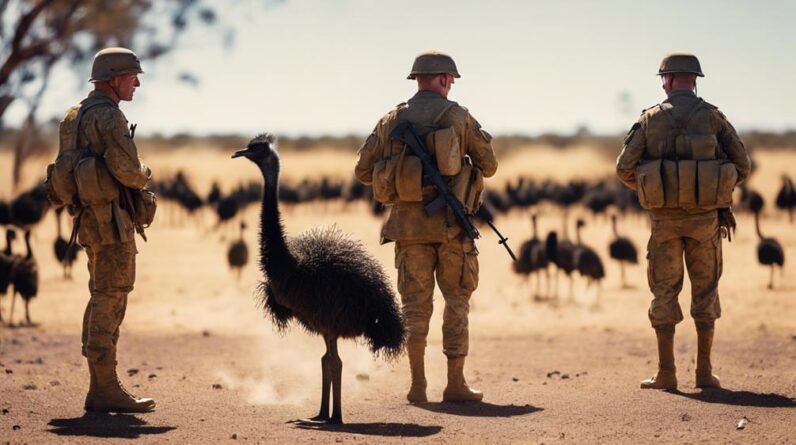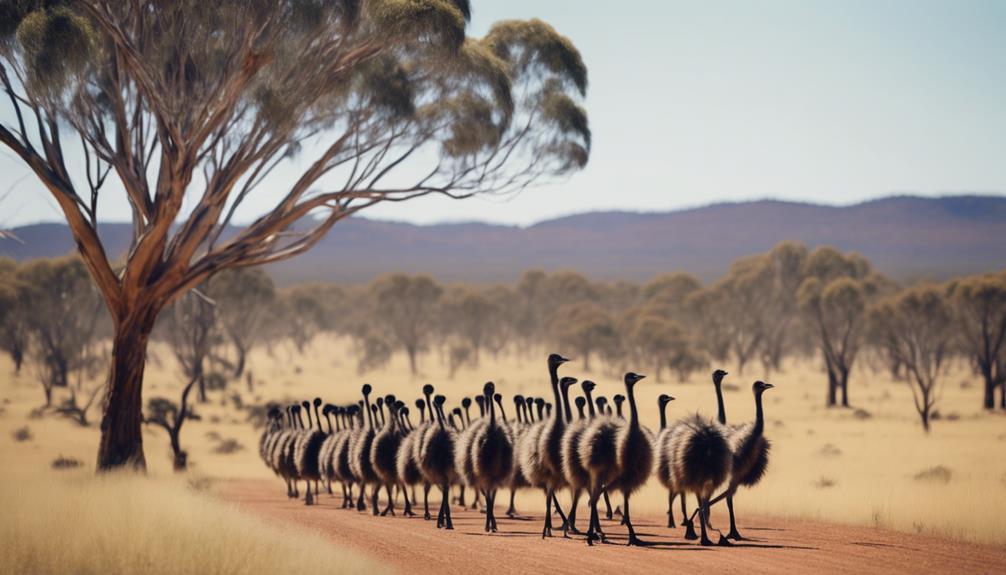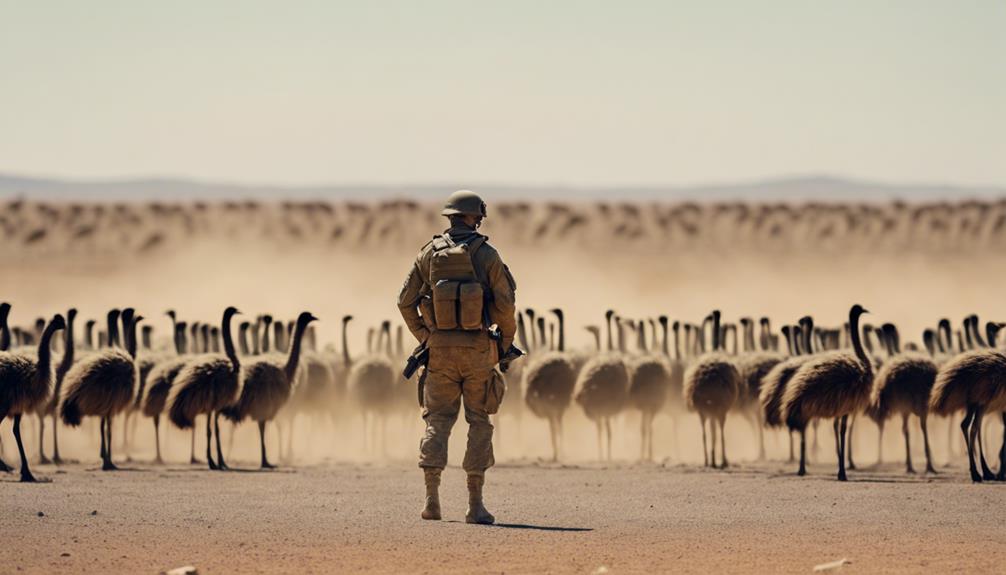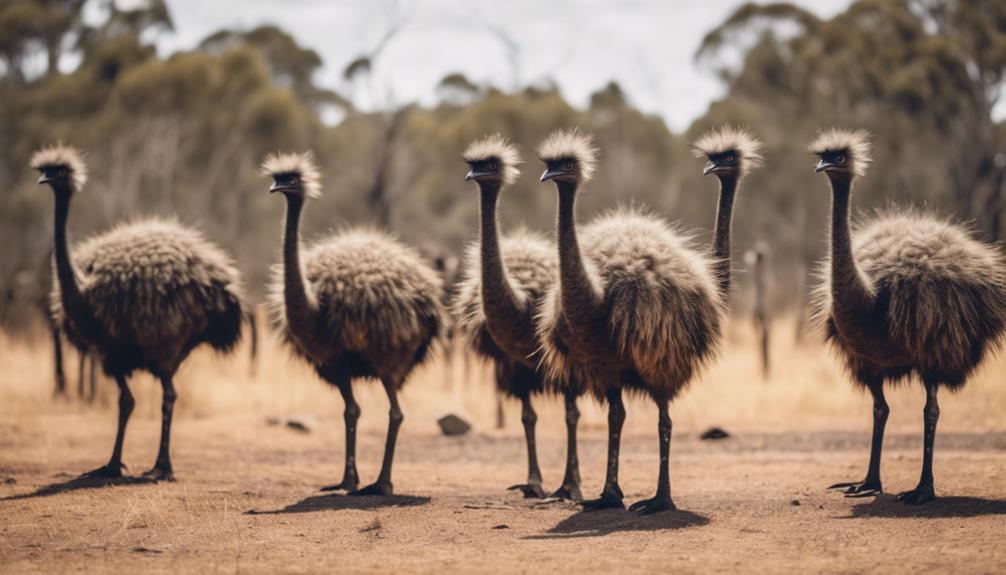
In the annals of Australian history, there exists a peculiar chapter that involves an unconventional conflict with the native emus.
As you contemplate the aftermath of what became known as the Emu War, you might be intrigued by the unexpected turns this wildlife encounter took and the valuable insights it offers.
The lessons drawn from this event transcend mere military strategy, delving into deeper ecological and societal implications that continue to resonate even in contemporary times.
Explore how this seemingly quirky episode holds relevance in understanding the delicate balance between humans and wildlife.
Key Takeaways
- Reassessment led to non-lethal approaches in wildlife management.
- Collaboration with experts enhanced conservation efforts.
- Emu War legacy highlights human-wildlife conflict resolution.
- Emphasizes sustainable practices for wildlife management.
Background of Emu Invasion

The relentless advance of the emus into Western Australia's farmlands in the 1930s marked a pivotal moment in the history of the region. Emus, known for their curious and inquisitive behavior, posed a significant threat to agriculture, causing extensive damage to crops and infrastructure. Their large size and voracious appetite led to widespread destruction in wheat fields, leading to substantial economic losses for farmers.
The emus' behavior of congregating in large numbers only exacerbated the situation, making it difficult for farmers to control the invasion effectively. As these flightless birds moved in flocks across the landscape, their impact on agricultural productivity became increasingly apparent. The damage inflicted by the emus not only affected individual farmers but also had broader implications for the region's economy as a whole.
Understanding the behavior of emus and the extent of their agriculture damage is crucial in comprehending the challenges faced during this critical period in Australian history. The invasion of emus highlighted the urgent need for a strategic response to mitigate the escalating conflict between humans and wildlife.
Military Response Initiated
Promptly initiating a military response was deemed imperative to address the escalating conflict with the emus in Western Australia. The military strategy devised aimed to combat the increasing emu population which posed a threat to agricultural lands. This intervention involved the deployment of soldiers armed with machine guns, under the command of Major G.P.W. Meredith, to cull the emus. The soldiers strategically positioned themselves near water sources where the emus gathered, intending to maximize their impact.
The military response was a calculated effort to swiftly diminish the emu numbers causing havoc among the farmers. However, despite the meticulous planning, the unpredictable nature of wildlife intervention presented unforeseen challenges that the soldiers had to navigate. The operation highlighted the complexities of using military force against wildlife, emphasizing the importance of understanding animal behavior in such endeavors. The lessons learned from this military response continue to resonate in discussions surrounding wildlife management and human-wildlife conflicts.
Challenges Faced by Soldiers

Initiating a military response against the emus in Western Australia presented soldiers with a myriad of challenges as they attempted to cull the escalating emu population threatening agricultural lands. The soldiers' morale was tested as they faced the relentless and agile emus, making it difficult to effectively control the situation. The sheer number of emus proved overwhelming, leading to frustration among the troops tasked with reducing their numbers. Strategic retreats became a common occurrence as soldiers struggled to combat the elusive birds, highlighting the complexity of the situation.
Soldiers found themselves in a constant battle of wits with the emus, adapting their strategies to try and gain the upper hand. Despite their training and preparedness, the unexpected resilience of the emus posed a significant challenge. As soldiers faced setbacks in their efforts, maintaining high morale became crucial to sustain their determination in the face of a seemingly insurmountable foe. The need for strategic retreats underscored the unpredictable nature of the conflict, requiring soldiers to regroup and reassess their approach to effectively address the emu threat.
Tactics Employed Against Emus
Employing various strategic maneuvers proved essential in the military campaign against the resilient emus in Western Australia. The soldiers faced a unique challenge that required a blend of wildlife control and military strategy. Let's delve into the tactics used to combat the emu threat:
| Tactic | Description | Outcome |
|---|---|---|
| Fencing | Erecting barriers to confine emus and limit their movement. | Restricted emu access to certain areas, aiding in control efforts. |
| Ambush | Surprise attacks on emu flocks to disorient and scatter them. | Caused chaos among emus, making them easier to manage. |
| Mounted Pursuit | Chasing emus on horseback to keep up with their swift pace. | Allowed soldiers to cover larger areas and engage emus effectively. |
These tactics, though challenging, showcased the adaptability and determination of the soldiers. By combining wildlife control methods with military strategies, they aimed to gain an upper hand in the ongoing conflict against the emus.
Impact on Emu Population

The impact on the emu population following the military campaign and tactics employed against them in Western Australia was significant. The relentless pursuit and use of machine guns led to a decrease in the emu population, affecting their ecosystem and behavior.
- Conservation Efforts: The decimation of the emu population highlighted the importance of implementing conservation efforts to protect vulnerable species like the emus.
- Emu Behavior: The aggressive tactics used during the campaign caused a shift in emu behavior, making them more cautious and elusive in their interactions with humans.
- Population Dynamics: The drastic reduction in the emu population had ripple effects on the ecosystem, disrupting the balance of wildlife in the region.
- Wildlife Management: The failed military campaign underscored the necessity of employing sustainable wildlife management strategies to address human-wildlife conflicts effectively.
Understanding the impact on the emu population is crucial for shaping future conservation and wildlife management practices.
Public Perception and Criticism
With varying degrees of skepticism and disapproval, the public perception and criticism surrounding the Emu War in Australia have sparked debates and reflections on the efficacy of the military intervention. The public backlash against the decision to deploy military forces against emus was palpable, with many questioning the necessity and wisdom of such a move. Media scrutiny intensified as images and reports of the failed attempts to control the emu population spread, leading to widespread criticism of the operation.
The public's reaction to the Emu War highlighted a disconnect between military strategies and the expectations of civilian populations. People were quick to voice their concerns about the use of excessive force against wildlife and the apparent lack of foresight in planning the campaign. The media played a crucial role in amplifying these criticisms, bringing the issue to the forefront of national attention.
Aftermath and Policy Changes

In the aftermath of the Emu War in Australia, the failed military intervention prompted significant policy changes and reflections on wildlife management strategies. The lessons learned from this event have shaped the way Australia approaches wildlife conservation and policy-making.
- Reassessment of Military Involvement: The Emu War highlighted the limitations of using military forces for wildlife management, leading to a reevaluation of such tactics.
- Increased Emphasis on Non-Lethal Methods: Policy changes favored non-lethal approaches such as habitat preservation and population control through humane methods.
- Collaboration with Conservation Experts: There was a shift towards consulting wildlife conservation experts to develop more effective and ethical strategies.
- Education and Public Awareness Campaigns: Efforts were made to educate the public about coexisting with wildlife and the importance of conservation.
These changes reflect a more holistic and sustainable approach to wildlife management, emphasizing the need for balancing human interests with the preservation of natural ecosystems. The Emu War served as a catalyst for these necessary policy adjustments in the realm of wildlife conservation.
Legacy of the Emu War
Following the failed Emu War military intervention in Australia, the enduring legacy of the conflict reveals profound insights into wildlife management strategies and policy adaptations. The lessons learned from this historical event have left a lasting impact on how we approach wildlife control and conservation efforts.
—
| Legacy of the Emu War | |
|---|---|
| Lessons Learned | Historical Significance |
| The Emu War highlighted the importance of understanding the behavior and ecology of wildlife before implementing control measures. | The Emu War serves as a cautionary tale, emphasizing the need for evidence-based decision-making in wildlife management. |
| Policy adaptations post-Emu War focused on non-lethal strategies such as habitat modification and deterrents, showcasing a shift towards more sustainable and humane approaches. | The Emu War remains a symbol of the complexities involved in balancing human interests with wildlife conservation, sparking ongoing debates in environmental ethics and governance. |
—
Reflecting on the legacy of the Emu War, it becomes evident that despite its initial failure, the event catalyzed significant advancements in wildlife management practices and policy frameworks.
Wildlife Management Considerations

Considerations for effective wildlife management encompass understanding species behavior, implementing sustainable control measures, and fostering harmonious coexistence between humans and wildlife. When addressing wildlife management, it's crucial to take into account the delicate balance of ecosystems and the impact that human activities can have on them. Conservation strategies play a pivotal role in ensuring the preservation of biodiversity while mitigating conflicts that may arise between wildlife and human interests.
- Habitat Preservation: Protecting natural habitats is essential for maintaining healthy wildlife populations and promoting biodiversity.
- Non-lethal Control Methods: Utilizing non-lethal methods, such as habitat modification or deterrents, can help manage wildlife populations without causing harm.
- Community Involvement: Engaging with local communities and stakeholders is vital for implementing successful wildlife management strategies that are socially acceptable and sustainable.
- Long-Term Monitoring: Regular monitoring of wildlife populations and their habitats is necessary to assess the effectiveness of management efforts and make informed decisions for future conservation actions.
Ecological Lessons Learned
Throughout ecological management endeavors, valuable insights have been gleaned from the intricate interplay between wildlife populations and their habitats. Ecological restoration has emerged as a critical tool in reversing environmental damage and preserving biodiversity. Lessons learned from the Emu War in Australia highlight the importance of balancing wildlife conservation efforts with sustainable land management practices. By understanding the delicate relationship between species and their ecosystems, we can work towards creating healthier environments for both animals and humans.
| Ecological Restoration | Wildlife Conservation |
|---|---|
| Involves restoring ecosystems to their natural state | Focuses on protecting and preserving wildlife populations |
| Aims to enhance biodiversity and ecological resilience | Seeks to prevent species extinction and promote coexistence |
| Often includes habitat restoration and reintroduction programs | Involves wildlife monitoring and research to inform conservation strategies |
| Requires long-term commitment and community involvement | Relies on partnerships with local communities, governments, and conservation organizations |
| Can help mitigate the effects of human activities on the environment | Plays a crucial role in maintaining ecological balance and harmony |
Human-Wildlife Conflict Reflections

Reflections on human-wildlife conflicts reveal the complex dynamics at play when human and animal interests intersect in shared environments. In the context of conflict resolution and wildlife conservation, it's crucial to consider various aspects that shape these interactions:
- Understanding Behavior: Recognizing the behavior patterns of wildlife can aid in predicting and mitigating potential conflicts before they escalate.
- Community Engagement: Involving local communities in decision-making processes fosters a sense of ownership and responsibility towards wildlife conservation efforts.
- Effective Communication: Clear communication channels between stakeholders are essential for addressing conflicts and finding mutually beneficial solutions.
- Sustainable Practices: Implementing sustainable practices that balance human needs with wildlife conservation goals is key to long-term conflict prevention.
Emu War's Modern Relevance
The modern relevance of the Emu War lies in its historical lessons for wildlife management and human-wildlife conflict resolution. The Emu War serves as a cautionary tale, highlighting the complexities and challenges of balancing human interests with wildlife conservation efforts. In today's world, where human-wildlife conflicts are on the rise due to habitat loss, climate change, and increasing human populations encroaching on natural habitats, the lessons from the Emu War carry significant weight.
The Emu War's modern implications underscore the importance of adopting sustainable and ethical practices in wildlife conservation. It prompts us to reevaluate our approaches to managing wildlife populations, emphasizing the need for holistic and science-based strategies. Furthermore, the Emu War reminds us of the necessity of understanding and respecting the natural behaviors and habitats of wildlife species to prevent conflicts and promote coexistence.
Frequently Asked Questions
How Did the Emus React to the Military Response Initiated During the Emu War?
When the military responded during the Emu War, the emus displayed cunning behavior. They evaded the soldiers' efforts, showcasing adaptability and intelligence. The emus' ability to outmaneuver the military response highlighted their resilience and survival instincts.
Were There Any Casualties Among the Soldiers Involved in the Emu War?
You'll be intrigued to learn that during the Emu War, there were no casualties among the soldiers. Despite their response to the emu threat, the soldiers managed to avoid any harm, showcasing their resilience.
What Was the Reaction of the International Community to the News of Australia Declaring War on Emus?
When news broke of Australia declaring war on emus, the international community was stunned. Diplomatic relations strained as nations questioned the seriousness of this quirky conflict. The absurdity of it all sparked confusion and disbelief.
Did the Emu War Have Any Long-Term Effects on the Agricultural Industry in Australia?
Long term impact of the Emu War on Australia's agricultural industry was significant. Emus' behavior continued to pose challenges post-war. While not resulting in military casualties, the conflict garnered mixed international response and Indigenous reactions, shaping future wildlife management strategies.
What Were the Reactions of Indigenous Australian Communities to the Emu War and Its Aftermath?
When considering Indigenous perspectives on the Emu War and its aftermath, it's crucial to acknowledge the profound cultural impact. Communities reacted with a mix of skepticism, frustration, and resilience, highlighting the complex relationship between history and identity.
Conclusion
As the dust settled on the Emu War, it became clear that nature can't be conquered as easily as imagined.
Like the emus, challenges in life may seem insurmountable at first, but with resilience and adaptability, victory is always within reach.
The lessons learned from this unique conflict serve as a reminder that humility and respect for the environment are essential in navigating the complexities of human-wildlife interactions.
The Emu War stands as a cautionary tale, urging us to tread lightly on the delicate balance of nature.





